
canadiancontractor
5 great exercises to relieve contractor aches and pains
Canadian ContractorKitchen and bath contractor Joel demonstrates simple exercises that can help your body to cope with job site stresses and strains
By Patrick Stiles, RMT
As contractors, manual labourers and home builders, you face a lot of unique challenges within your workplace. As a massage therapist, I have seen many unique and troublesome injuries amongst contractors. In this article, I will be going over how to treat and hopefully prevent these injuries.
One chief complaint from anyone who works in manual labour is low back pain. I once treated a contractor who “put out” his low back and was in excruciating pain, initially unable to do anything but lie on the floor. The pain started after he simply bent forward to pick something up. How can such a small action result in such pain?
The answer is that it is not uncommon to injure your low back while bending forward putting on socks, tying up shoe laces, or even sneezing. Research by Dr Stuart McGill at the University of Waterloo has shown that repeated lumbar flexion (rounding of the low back) can weaken the discs in the spine and cause herniation of the discs in the lumbar spine. In the case of the above contractor, therefore, his mechanism of injury was not necessarily bending down to pick something up, but rather years of being crouched over at work with a rounded back, with little to no attention given to maintaining a neutral spine, hip mobility and proper biomechanics.
What does this mean for the contractor that is constantly bending forward, lifting heavy things and stuck in awkward positions? It means that you need to have good hip mobility, spinal movement awareness, a strong core and strong glutes in order to avoid injury. Hopefully this article will help you to develop these things!
Joel, the contractor in the pictures that follow, has been a counter top installer for 13 years and has also had some episodes of low back pain. He says that deadlifts and squats have helped him to develop the strength and mobility required to do his job since he started working out seriously a few years ago. However, upon assessment, his squat and deadlift form were not perfect and involved a little bit of lumbar flexion (the “butt wink”, or rounded lower back) at the bottom of his squat, which was a likely culprit of his low back pain. When fatigue, stress and gravity set in at work, our bodies suffer. This is why we need to develop our awareness of our own body mechanics so that it all becomes second nature.
Of the five corrective exercises I will discuss here, number one is the hip hinge. If the hips do not move properly and the low back bends while lifting, then we’re in trouble. The goal here is to have all flexion and extension coming from the hips while the spine stays neutral. This is a fundamental exercise to help with squats, deadlifts and to help create proper habits when bending over and lifting things up or putting them down.
1. The Hip Hinge
The hip hinge can be done on all fours, kneeling or standing. For the purposes of this article we will demonstrate the kneeling version.
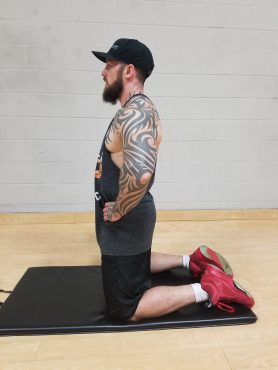
Hip Hinge, Starting Position
Assume a kneeling position with your hands on your hips. Ensure that your ears, shoulders and hips are all in alignment.
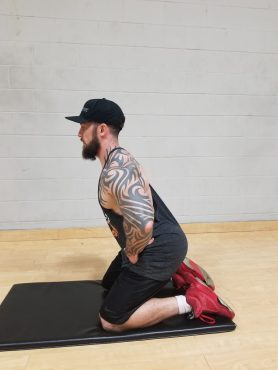
Hip Hinge, Finishing Position
Slowly rock the hips backwards and go as far as you can before the low back starts to round. Return to the beginning position and repeat this 10-15 times. If you are having a hard time with the motion, then begin on all fours, and rock your buttocks back towards your heels, remembering to only go as far you can without the low back rounding.
Now that we’ve mastered the hip hinge it is time to strengthen the entire low body as well as the core and to work on mobility. In modern times we have embraced sitting – in cars, at desks, on the couch, etc. We have lost out on the benefits of relaxing while in a squat position, as is still the norm in many cultures. It is easy for our glutes and core to become weak and disengaged as a result of all this sitting. The following exercise can help us regain that strength in the glutes, our core, and restore flexibility in the ankles, calves, hips and groin.
Next time you’re on a break, consider opting for an active squat instead of sitting on a chair or bench.
The Squat
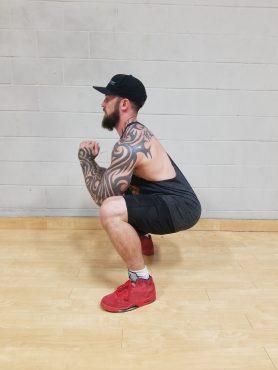
Squat, Unassisted Version
Stand with your feet shoulder width apart, toes pointed only slightly out at 10 and 2. Using the hip hinge movement discussed earlier, slowly go back into a squat position while bending the knees and maintaining the curve in the low back. Place your elbows or forearms inside of your knees. Keep the chest and head up and maintain the curve in the lumbar spine. Breathe normally. If this position is too intense, come up a bit higher, or sit on something higher (see below, Assisted Squat). You can hold this anywhere from 20 seconds to 3 minutes. A small amount of discomfort in the glutes and thighs is ok, as is a little stretch in the groin, but you should not experience any pain. The upper body should be relaxed and in good alignment.
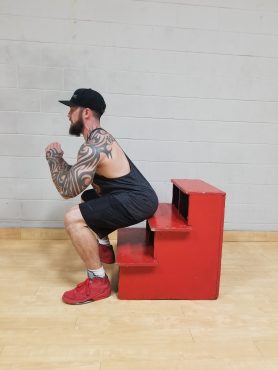
Squat, Assisted Version
Here, Joel demonstrates the assisted version of the squat, for those who are unable to squat to 90 degrees or more while maintaining the lumbar curve. You can use a yoga block, a lunch box, a step, or something similar for support.
When we are crouched over or sitting for long periods of time with our hip flexors in a shortened position, they can become tight and even fibrotic, making it very difficult for them to relax and stretch. When you experience discomfort in the low back after sitting or crouching forward, resist the urge to stretch the low back, and instead try stretching the hip flexors.
The Hip Flexor Stretch
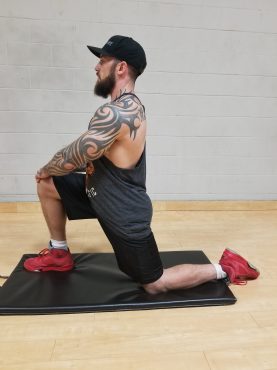
Kneeling Hip Flexor Stretch
Kneel on one knee and push your hands into your other knee to sit up tall. Keep the core engaged, push the hips forward until you feel a slight pull in the front of the hip. Hold this for 20-30 seconds on each side. Repeat 2-3 times. Always make sure you’re warm before doing any stretching – a short 5 minute walk would be sufficient in this case. This stretch can be done daily.
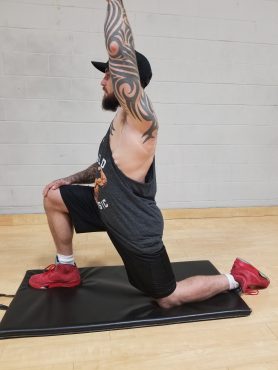
Kneeling Hip Flexor Stretch with Arm Up
Raising the arm up over head will make this stretch a little more intense and will also target the fascia (i.e. soft tissues) in the entire anterior torso (i.e. front upper body), stretch pec minor (i.e. the chest), as well as strengthen all the postural muscles of the mid and upper back. Try raising both arms for added strengthening of the back.
With jobs that involve lifting and working in front and overhead, the posterior chain (i.e., all the muscles in the back) tend to get weak and underutilized. This next exercise is an excellent one to strengthen the entire posterior chain, to help create awareness of the relationship between your head and your spine, to increase balance and stability, and to strengthen many of the core muscles. If you haven’t tried the “bird dog” before, you’ll love it and want to make it part of your daily routine.
The Bird Dog
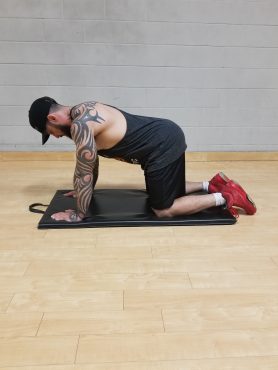
Bird Dog, Starting Position
Start on your hands and knees, with your hands under your shoulders and your knees under your hips. Ensure that your head is in good alignment with your spine, that your spine is neutral and that the core is engaged. If possible use a side mirror for feedback, or ask a friend to check your alignment.
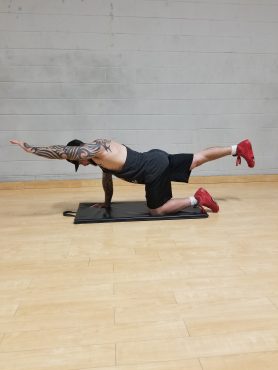
Bird Dog, Finishing Position
Raise your right arm off the ground to be in line with your torso. Then kick your left leg back until it’s also in line with your torso. Hold this for 5-10 seconds. Repeat this 5-10 times then switch to the other side for 5-10 reps. Try the bird dog as a warm up to your day, or any time you feel like your back is a little uncomfortable.
Now that you have learned how to move your hips with a neutral spine (hip hinge), how to strengthen your lower body and increase balance and mobility (squat and bird dog), and how to stretch the hip flexors, it’s time to move up to the shoulders and talk about a common issue there.
When reaching forward, it is common to protract the shoulders by rolling them forward instead of hinging from the hips (observe a toddler reaching for something for excellent biomechanical instruction on how to reach for something).
A lack of scapular stabilization can cause pain in between the shoulder blades as those muscles have to work far harder than they should to maintain your upper body posture. Upper cross syndrome is a very common condition involving overactive and underactive muscle groups. For example, tight overactive muscles in the chest that are imbalanced with lengthened underactive muscles between the shoulder blades will make you hunch forward, rounding your upper back. Without correcting these muscular imbalances, we leave ourselves vulnerable to injury including rotator cuff strains. Here is the exercise you need…
The Scapular Retraction
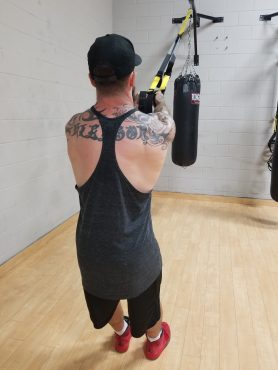
Scapular Retraction, Start, Rear View
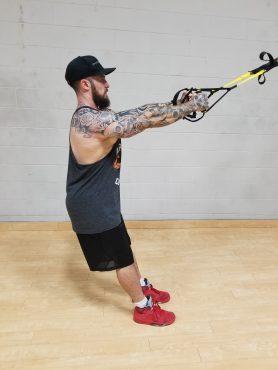
Scapular Retraction, Start, Side View
Attach an exercise band to a pole or doorknob, use a rope on the cable machine at the gym, use TRX straps, or even grab the sides of a narrow door frame.
Straighten your arms and let your shoulders come forward to get a good stretch in between the shoulder blades. This is your start position in which pecs and serratus anterior are shortened and rhomboids and middle traps are lengthened.
Your grip can be shoulder height or slightly higher or lower. The key is to isolate this movement to the area between the shoulder blades and nowhere else
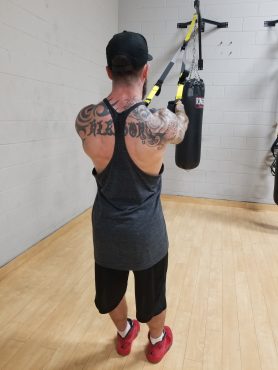
Scapular Retraction, Finish, Rear View
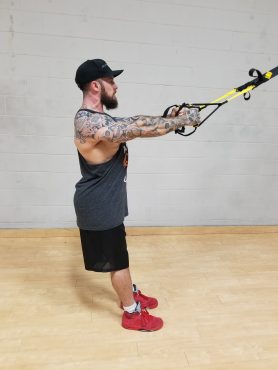
Scapular Retraction, Finish, Side View
Keep your arms straight and relaxed and squeeze the shoulder blades together. Make sure your head does not come forward. This is a very small movement if it is done correctly. Hold this final contraction for 5-10 seconds, return to the starting position and repeat 5-10 times. Do this every day and eventually holding your shoulders in the retracted position will feel much more natural.
The above exercises will hopefully help you to take an active role in your health and help you prevent injuries. Like many manual labour jobs, your job likely involves lifting, reaching, crouching, and other positions that can become uncomfortable. With these tips, you can help make work less of a pain.
ABOUT THE AUTHOR
 Patrick Stiles, RMT, graduated from Sutherland-Chan in 2007 and began his career at the Health and Performance Centre at the University of Guelph. Since 2010, he has been the Director of Massage Therapy at Wellington Ortho & Rehab Associates. Outside of the busy clinic, Patrick has been fortunate to work with dancers on set of The Next Step, and with our National and Olympic teams in wrestling and track cycling. Patrick juggles massage therapy with a career as a musical theatre performer, supervises a sports outreach at the University of Guelph for CCMH (Cambridge campus) and has two dogs, a cat and a husband.
Patrick Stiles, RMT, graduated from Sutherland-Chan in 2007 and began his career at the Health and Performance Centre at the University of Guelph. Since 2010, he has been the Director of Massage Therapy at Wellington Ortho & Rehab Associates. Outside of the busy clinic, Patrick has been fortunate to work with dancers on set of The Next Step, and with our National and Olympic teams in wrestling and track cycling. Patrick juggles massage therapy with a career as a musical theatre performer, supervises a sports outreach at the University of Guelph for CCMH (Cambridge campus) and has two dogs, a cat and a husband.
REGISTERED MASSAGE THERAPISTS’ ASSOCIATION OF ONTARIO (RMTAO)
The Registered Massage Therapists’ Association of Ontario (RMTAO) is a member-driven, not-for-profit professional association for Registered Massage Therapists (RMTs) in Ontario. The RMTAO exists in order to advance the profession of massage therapy in Ontario.
For further information please visit www.rmtao.com or email: info@rmtao.com.

Leave a Reply